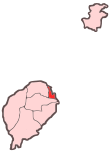Portal:São Tomé and Príncipe
 São Tomé and Príncipe, officially the Democratic Republic of São Tomé and Príncipe, is an island country in the Gulf of Guinea, off the western equatorial coast of Central Africa. It consists of two archipelagos around the two main islands of São Tomé and Príncipe, about 150 km (93.21 mi) apart and about 250 and 225 km (155 and 140 mi) off the northwestern coast of Gabon. With a population of 201,800 (2018 official estimate), São Tomé and Príncipe is the second-smallest and second-least populous African sovereign state after Seychelles. The islands were uninhabited until their discovery in 1470 by Portuguese explorers João de Santarém and Pedro Escobar. Gradually colonized and settled throughout the 16th century, they collectively served as a vital commercial and trade centre for the Atlantic slave trade. The rich volcanic soil and proximity to the equator made São Tomé and Príncipe ideal for sugar cultivation, followed later by cash crops such as coffee and cocoa. The lucrative plantation economy was heavily dependent upon enslaved Africans. Cycles of social unrest and economic instability throughout the 19th and 20th centuries culminated in peaceful independence in 1975. São Tomé and Príncipe has since remained one of Africa's most stable and democratic countries. São Tomé and Príncipe is a developing economy with a medium Human Development Index. The people of São Tomé and Príncipe are predominantly of African and mestiço descent, with most practicing Christianity. The legacy of Portuguese rule is also visible in the country's culture, customs, and music, which fuse European and African influences. São Tomé and Príncipe is a founding member state of the Community of Portuguese Language Countries. (Full article...) Selected article - The Cameroon line (French: Ligne du Cameroun, Portuguese: Linha dos Camarões, Spanish: cordillera de Camerún) is a 1,600 km (1,000 mi) long chain of volcanoes that includes islands in the Gulf of Guinea and mountains on the African mainland, from Mount Cameroon on the coast towards Lake Chad on the northeast. They form a natural border between eastern Nigeria and the West Region of Cameroon. The islands, which span the equator, have tropical climates and are home to many unique plant and bird species. The mainland mountain regions are much cooler than the surrounding lowlands, and also contain unique and ecologically important environments. The Cameroon volcanic line is geologically unusual in extending through both the ocean and the continental crust. Various hypotheses have been advanced by different geologists to explain the line. (Full article...) This is a Good article, which meet a core set of high editorial standards.
São Tomé and Príncipe competed at the 2004 Summer Olympics in Athens, Greece, which was held from 13 to 29 August 2004. The country's participation at Athens marked its third appearance in the Summer Olympics since its debut in the 1996 Summer Olympics. Two track and field athletes, Yazaldes Nascimento and Fumilay Fonseca, were selected to represent the nation via wildcards, as the nation had no athletes that met either the "A" or "B" qualifying standards. Fonseca was selected as flag bearer for the opening ceremony. Fonseca was also notable for becoming the youngest ever athlete to represent São Tomé and Príncipe at the Summer Olympics, aged 16 years and 92 days. This is a record which still stands today. (Full article...) CategoriesDid you know -
Selected picture -In the news
Things to do
Topics– Districts –
Related portalsAssociated WikimediaThe following Wikimedia Foundation sister projects provide more on this subject:
Discover Wikipedia using portals
|











































